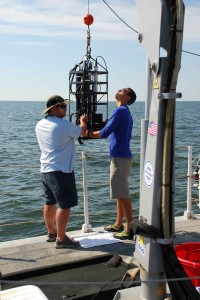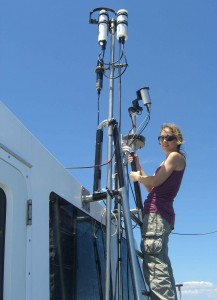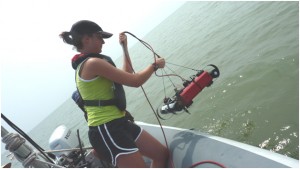by Kristen Minogue
On a hot afternoon in July, a team of researchers sailing down Chesapeake Bay stumbled across a cluster of striped bass floating in the water. About a dozen of the iridescent black and silver fish bobbed at the surface near the ship’s bow. All of them were dead.

Scientists prepare to measure how light interacts with particles in the Bay. Credit: Carlos DelCastillo
The fish kill came out of a low-oxygen zone near Annapolis, just one symptom of the Bay’s declining health. Overflows of nutrients from farms and cities have fueled massive growths of algae that cut off light and oxygen to the Bay’s lower levels.
“There was a very quiet moment between everybody on the boat,” recalled Vienna Saccomanno, one of the Smithsonian research interns aboard when it was discovered. “You kind of knew what everyone was thinking, feeling empowered to continue with this research and hopefully contribute to prevention of this in our water system.”
The scientists on board weren’t there simply to document the Bay’s many ailments, however. They had joined the 10-day cruise to pave the way for a much larger goal: a geostationary satellite that could provide constant, detailed coverage of coastal health.
NASA satellite instruments have tracked water quality in the past by measuring ocean color – the amount of phytoplankton, dissolved organic matter and sediment in the water. But they took their measurements from polar orbits, meaning they circled the Earth from pole to pole. It’s an ideal system for scientists who want to collect global data in a short amount of time. A geostationary satellite would remain fixed over the same point, thousands of miles above Earth’s surface.
It would be a first for NASA. On dynamic systems like the coasts, having a satellite to track their changes non-stop would give scientists a wealth of information they wouldn’t have otherwise. Example: How does water quality change throughout the day? In shallower waters oxygen levels often go through daily cycles, from lethally low at night to super-saturated by early afternoon. This would enable scientists to monitor those changes much more closely.

Campaign co-chief scientist Maria Tzortziou aboard the research ship NOAA-SRVx. Tzortiou said unusually high nutrient levels created a large dead zone in the Bay this year, resulting in fish kills like the one the team spotted during their mission. Credit: Vienna Saccomanno
The mission, GEO-CAPE (Geostationary Coastal and Air Pollution Events), is still years from launch – almost certainly later than 2020, says Tzortziou. And before they can put it in the air, researchers need to make sure the data they would get from space is reliable. To resolve that question, more than 20 scientists from nine institutions, including NASA, NOAA and the Smithsonian Environmental Research Center, teamed together to sail down Chesapeake Bay. Tzortziou, a University of Maryland scientist and SERC research associate, led the investigation with Antonio Mannino, an oceanographer at Goddard Space Flight Center. Over 10 days the researchers collected data on water and air quality for their own research and to compare with data already being taken by NASA satellites.
The boat held three SERC researchers, interns Vienna Saccomanno and Avery Bullock and a former intern turned science aid, John Dacquisto. Collectively, the trio spent seven days aboard the NOAA boat sampling organic matter clouding the water (Bullock spent one, and Saccomanno and Dacquisto each spent three). Starting in Annapolis every morning, the boat would travel north, south or west, stopping five or six times a day to allow the scientists to sample the water at different sites, a process that could take a couple hours. Sometimes the boat followed the current. And occasionally, they did tidal studies – in which the boat would sit at the same location for the entire day and take samples every hour and a half, according to Dacquisito. “Usually those days would be pretty long.”

Vienna Saccomanno lowers a two-way in-water profiling radiometer out of the inflatable Zodiac. The instrument measures how much visible and UV light radiation is leaving the water. Credit: Stan Hooker/NASA
The SERC team came on board to sample colored dissolved organic matter, dissolved material that colors the waters in the Bay. By filtering it out and observing how it absorbed and fluoresced light in the lab, they could tell whether it had come into the Bay from land or from some other source. Other scientists measured trace gases in the air to track pollution, or how deep the sun’s energy penetrated into the water column. Eventually they hope what they and the satellite discover could prevent fish kills like the one found in the waters this summer.
For more details about the cruise and GEO-CAPE, visit NASA.

